News & Updates Archive 2020
22 December
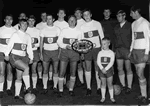 A month ago I posted a photograph of Stockport County from 1967-68 wearing their distinctive white shirts with a broad blue band and yellow trim on the shorts and socks. I had a long standing memory that the trimmings were tangerine the following season and red after that but was not able to corroborate this so deleted these graphics. Memory is not always reliable especially over such a distance in time. Recently, however, Des Hinks has furnished photographs from the two missing seasons and while these are in black and white, it is clear that the trimmings are darker in 1968-69 and darker still a season later.
A month ago I posted a photograph of Stockport County from 1967-68 wearing their distinctive white shirts with a broad blue band and yellow trim on the shorts and socks. I had a long standing memory that the trimmings were tangerine the following season and red after that but was not able to corroborate this so deleted these graphics. Memory is not always reliable especially over such a distance in time. Recently, however, Des Hinks has furnished photographs from the two missing seasons and while these are in black and white, it is clear that the trimmings are darker in 1968-69 and darker still a season later.
The photograph is from 1968-69 and features Len Allchurch receiving a presentation plate to mark his 500th senior appearance.
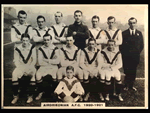 (Photo credit: Stockport County FC Match Programme)
(Photo credit: Stockport County FC Match Programme)
Scottish Clubs from Football & the First World War
Aberdeen (1920-21), Airdrieonians (1920-21 see right), Albion Rovers (1920-21), Ayr United (1920-21), Clyde (1920-21), Morton (1920-21), Hamilton Academicals (1920-21), Raith Rovers (1920-21) added.
(Photo credit: Roger Pashby & Matt Stevens/Football & the First World War)
10 December
Our St Petersburg Elf, Pavel Shalaev, recently sent me a link to the Football & the First World War website which has a fine collection of team photographs dating from the years immediately before and after the war. From these I've been able to make the following updates: Bradford City (socks corrected on graphics 1909-1920), Derby County (1912-13 collar added), Huddersfield Town (1914-15 added), Leeds United (1920-21 added), Leicester Fosse (1914-15 added), Middlesbrough (epaulettes enlarged on 1913-1936  graphics), Newcastle United (1914-15 added).
graphics), Newcastle United (1914-15 added).
The photograph is of the Brentford team from 1914-15 and shows them wearing the yoked tops that were popular at the time. Curiously there are 18 players in the picture and several of them are wearing reversed jerseys. Presumably they did not have enough blue/yellow tops to go round the squad so some players had to wear their change tops.
(Credits Paul Briers/Football & the First World War)
9 December - Aston Villa 1892-93
 Unravelling the complex history of Aston Villa's kits in the Victorian period has been both challenging and rewarding and, although we have made a great deal of progress over the last two years, there are still some surprises to be found. This
Unravelling the complex history of Aston Villa's kits in the Victorian period has been both challenging and rewarding and, although we have made a great deal of progress over the last two years, there are still some surprises to be found. This 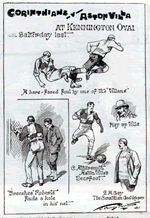 commemorative certificate presented to John Devey to mark his benefit match in 1896 shows a Villa player wearing a quartered shirt but I had previously dismissed this, assuming the artist had misinterpreted the term which at the time usually described what we know as "halved" shirts.
commemorative certificate presented to John Devey to mark his benefit match in 1896 shows a Villa player wearing a quartered shirt but I had previously dismissed this, assuming the artist had misinterpreted the term which at the time usually described what we know as "halved" shirts.
The cutting on the right, submitted by Villa Elf, Lee Gauntlett, illustrates the Corinthians v Aston Villa game  played in March 1893 and once again quarters are in evidence. This prompted me to look again at my photograph archive where I found this 1893-94 group showing the team posing with the committee and some impressive trophies. At first glance the players are wearing two different shirt styles, but when I examined it more closely I noticed two players are in quartered tops. (Click the thumbnail to view a larger image.)
played in March 1893 and once again quarters are in evidence. This prompted me to look again at my photograph archive where I found this 1893-94 group showing the team posing with the committee and some impressive trophies. At first glance the players are wearing two different shirt styles, but when I examined it more closely I noticed two players are in quartered tops. (Click the thumbnail to view a larger image.)
My conclusion is that quarters were worn for at least part of the 1892-93 season and a couple of these resurfaced when the team was assembled a year later, kitted out in mismatched tops.
(Credits: claretandblue.blog, Penny Illustrated 18 March 1893, Aston Villa From the Archive.)
8 September - Scottish Clubs 1952-54
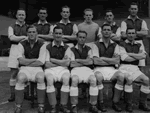 We have known for some time that Hearts wore maroon shirts with white sleeves in floodlit matches in the late 50s but we now have evidence that these smart tops appeared in 1952-53 on at least four occasions and again the following season.
We have known for some time that Hearts wore maroon shirts with white sleeves in floodlit matches in the late 50s but we now have evidence that these smart tops appeared in 1952-53 on at least four occasions and again the following season.
(Photograph Aberdeen FC Official Website.)
Third Lanark (1952-53 added), Dundee (1952-54 strip added to shorts), Motherwell (1951-54, 1954-57 socks updated), Raith Rovers (three strips worn 1952-53 added or modified, two strips from 1953-54 added), Heart of Midlothian (1952-53 alternative added, 1953-54 three strips added), Clyde (1952-53 now known to be the same as previous season. 1953-54 added), St Mirren (1952-55 updated), Airdrieonians (two 1953-54 strips added), Berwick Rangers (1953-54 collar amended).
3 December
 Here's a nice snippet that Tony Sealey turned up while researching the British Newspaper Archives. It appears that a week before their FA Cup tie with Liverpool in January 1936, Arsenal decided to try out the alternative shirts they would wear in that match (both teams were required to wear change shirts). Their kit manager seems to have been a belt, braces, safety pins and another belt sort of chap as he laid on no fewer than four alternatives for the team to choose from. These included two sets of their familiar red shirts with white sleeves, two dozen red and white striped shirts (considered too narrow for their liking), two dozen borrowed from Sheffield United (with broader stripes) and two sets of shirts with broad red and white hoops. The latter were selected for the game as can be seen in the poor quality image above and were subsequently worn at Anfield.
Here's a nice snippet that Tony Sealey turned up while researching the British Newspaper Archives. It appears that a week before their FA Cup tie with Liverpool in January 1936, Arsenal decided to try out the alternative shirts they would wear in that match (both teams were required to wear change shirts). Their kit manager seems to have been a belt, braces, safety pins and another belt sort of chap as he laid on no fewer than four alternatives for the team to choose from. These included two sets of their familiar red shirts with white sleeves, two dozen red and white striped shirts (considered too narrow for their liking), two dozen borrowed from Sheffield United (with broader stripes) and two sets of shirts with broad red and white hoops. The latter were selected for the game as can be seen in the poor quality image above and were subsequently worn at Anfield.
Scottish Clubs 1950-52
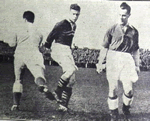 We have more today from Ian McConnel: Morton (1950-51 added), East Fife (1950-51 collar corrected, 1951-52 added), Raith Rovers (1950-Jan 1951 added, Feb-May 1951 socks corrected and four different strips worn in 1951-52 added - see right for March 1952 version) , Clyde (1950-52 added), St Mirren (1951-52), Heart of Midlothian (1950-51, Aug-Dec 1951 added), Third Lanark (1951-52 added), Elgin City (1949-54 detailing updated).
We have more today from Ian McConnel: Morton (1950-51 added), East Fife (1950-51 collar corrected, 1951-52 added), Raith Rovers (1950-Jan 1951 added, Feb-May 1951 socks corrected and four different strips worn in 1951-52 added - see right for March 1952 version) , Clyde (1950-52 added), St Mirren (1951-52), Heart of Midlothian (1950-51, Aug-Dec 1951 added), Third Lanark (1951-52 added), Elgin City (1949-54 detailing updated).
1 December
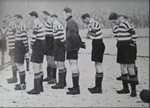 Our very good chums Tony Sealey and Richard Essen have been burrowing in the British Newspaper Archives looking through pre-war copies of the Daily and Sunday Mirrors that were added to the archive over the summer. Thanks to their efforts I've been to update the Tottenham Hotspur Change Kit section with six previously unrecorded strips, such as these red and white rugby shirts worn
Our very good chums Tony Sealey and Richard Essen have been burrowing in the British Newspaper Archives looking through pre-war copies of the Daily and Sunday Mirrors that were added to the archive over the summer. Thanks to their efforts I've been to update the Tottenham Hotspur Change Kit section with six previously unrecorded strips, such as these red and white rugby shirts worn 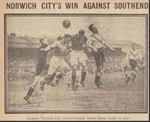 in November 1925, as well as a number of corrections and adjustments to dates.
in November 1925, as well as a number of corrections and adjustments to dates.
Included in the material Tony and Rich sent me was this cutting of Norwich City v Southend United from September 1925. This is the first photographic evidence I have seen that confirms the design of the unusual yellow and green chevron worn by Norwich at the time.
30 November
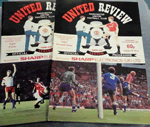 In my post about the mystery white Everton shirt on 23 November I mentioned the possibility that it may have been worn in the 1988 Mercantile Trophy. Nik Yeomans has now provided me with a match programme that has a photograph of the Manchester United - Everton tie in question which shows the Toffees in an all-blue strip. It looks like that white shirt was never worn in a competitive game.
In my post about the mystery white Everton shirt on 23 November I mentioned the possibility that it may have been worn in the 1988 Mercantile Trophy. Nik Yeomans has now provided me with a match programme that has a photograph of the Manchester United - Everton tie in question which shows the Toffees in an all-blue strip. It looks like that white shirt was never worn in a competitive game.
26 November
Southampton (2018-19 3rd & 2019-20 4th corrected), Burnley (2019-20 4th kit added).
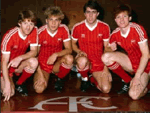 In September 1982 Aberdeen travelled to Albania to play Dinamo Tirana in the European Cup-Winners Cup and wore this one-off strip, basically identical to their
In September 1982 Aberdeen travelled to Albania to play Dinamo Tirana in the European Cup-Winners Cup and wore this one-off strip, basically identical to their 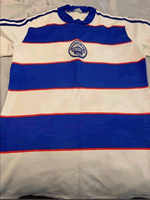 regular outfit but with contrasting V necks and cuffs.
regular outfit but with contrasting V necks and cuffs.
Here is another odd variant, worn by Morton in a few matches during the 1983-84 season. It's an Adidas shirt similar to those worn by Queens Park Rangers at the time but not identical.
I'm grateful to Martin Johnston, General Manager of Peterhead FC, who has submitted a photograph of the team's 1946-47 strip which provides us with details about the design of the crest worn around this time.
24 November
 This strip, worn by Stockport County in 1967-68, has always been one of my favourites. At the time strips were remarkably unifom and plain so teams that adopted more unconventional styles like this one really stood out.
This strip, worn by Stockport County in 1967-68, has always been one of my favourites. At the time strips were remarkably unifom and plain so teams that adopted more unconventional styles like this one really stood out.
(Photograph Football League Review.)
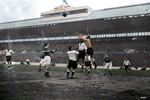 This colourised photograph shows England playing Germany at White Hart Lane on 4 December 1935. This is the only occasion on which England wore change shirts prior to the outbreak of the Second World War. Incidentally, the staunchly amateur FA insisted that players provide their own dark knickers and socks up until 1932. It appears likely that they were finally stung by press criticism of the scruffy appearance of the English national team into providing uniform kits in 1932.
This colourised photograph shows England playing Germany at White Hart Lane on 4 December 1935. This is the only occasion on which England wore change shirts prior to the outbreak of the Second World War. Incidentally, the staunchly amateur FA insisted that players provide their own dark knickers and socks up until 1932. It appears likely that they were finally stung by press criticism of the scruffy appearance of the English national team into providing uniform kits in 1932.
(Photograph may be subject to copyright.)
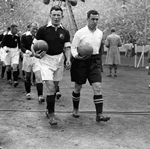 Steve Flanagan has found some interesting background to the strips worn in the 1933 FA Cup final between Everton and Manchester City. Prior to the game, in accordance with FA Cup rules, the clubs agreed their colours for the match. City would play in red shirts and white knickers while Everton would wear white shirts, black shorts and socks, all with blue trimmings. As the senior club, Everton thought they were entitled to retain a blue motif but they reckoned without the disdainful approach of the FA to the professional game. On 11 April the Liverpool Echo reported, "A real bolt from the blue has happened in regard to the FA Cup final....Now the FA has ruled that both clubs shall leave blue entirely out of the picture."
Steve Flanagan has found some interesting background to the strips worn in the 1933 FA Cup final between Everton and Manchester City. Prior to the game, in accordance with FA Cup rules, the clubs agreed their colours for the match. City would play in red shirts and white knickers while Everton would wear white shirts, black shorts and socks, all with blue trimmings. As the senior club, Everton thought they were entitled to retain a blue motif but they reckoned without the disdainful approach of the FA to the professional game. On 11 April the Liverpool Echo reported, "A real bolt from the blue has happened in regard to the FA Cup final....Now the FA has ruled that both clubs shall leave blue entirely out of the picture."
The dark shade of City's tops in contemporary photographs led me to believe they were maroon but this is our old nemesis, orthographic film stock at work. According to the official match programme they wore scarlet shirts.
City were back in the final the following season when, according to the match programme, they did wear maroon.
(Photograph may be subject to copyright.)
23 November
 This odd Everton shirt was featured several times in News & Updates as far back as 2008 and it seems that questions about it have been circulating on social media recently. In September 2008 David France and Steve Flanagan confirmed that this was the team's official third shirt between 1986 and 1989 but it was never worn in a competitive match. If it was used it may have appeared in August 1988 at Old Trafford when Everton were beaten 1-0 by Manchester United in the Mercantile Trophy, a one-off competition organised to mark the centenary of the Football League, but I've not been able to confirm this. Since it continues to turn up like the proverbial bad penny I've now added it to the archive.
This odd Everton shirt was featured several times in News & Updates as far back as 2008 and it seems that questions about it have been circulating on social media recently. In September 2008 David France and Steve Flanagan confirmed that this was the team's official third shirt between 1986 and 1989 but it was never worn in a competitive match. If it was used it may have appeared in August 1988 at Old Trafford when Everton were beaten 1-0 by Manchester United in the Mercantile Trophy, a one-off competition organised to mark the centenary of the Football League, but I've not been able to confirm this. Since it continues to turn up like the proverbial bad penny I've now added it to the archive.
Ian McConnel has submitted another batch of minor amendments for Scottish clubs, this time for 2018-19. Rangers (1st, 2nd, 3rd), St Mirren, Kilmarnock, Hamilton Academical, St Johnstone, Hibernian, Motherwell.
2020-21 Update: Dumbarton and East Fife shirt sponsorship added.
10 November
I have finally got round to reviewing Paul Brett's personal collection of Shrewsbury Town shirts, photographs of which he recently posted on his website, Shrewsbury Town Football Shirts 1974 to Present. Armed with this material I have been able to update a lot od detailing on shirts between 1982 and 1999.
30 October - More Scottish Post-War Updates
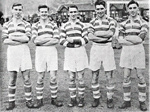 Clyde (Aug-Sept 1946, October 1946 added), Greenock Morton (1948-49 added - see left), Heart of Midlothian (March 1949-1950 added), Stirling Albion (1949-50 added), Queen of the South (1947-52 socks modified), Raith Rovers (1949-50 socks modified).
Clyde (Aug-Sept 1946, October 1946 added), Greenock Morton (1948-49 added - see left), Heart of Midlothian (March 1949-1950 added), Stirling Albion (1949-50 added), Queen of the South (1947-52 socks modified), Raith Rovers (1949-50 socks modified).
29 October - Scottish Post-War Kits
Ian McConnel has been scouring through his collection of Rangers match programmes and come up with some amendments for the late 1940s. St Mirren (1945-46 collar and stripes corrected), Dundee (Feb-April 1946 added), Alloa Athletic (1945-46 added).
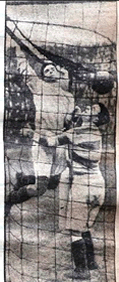 On the left is the unfortunate Stenhousemuir goalkeeper, "supported" by one of his defenders, failng to stop a corner flying directly into his goal in high winds. The action is from a Scottish Victory Cup match against Rangers in April 1946 ('Gers won 8-2 on aggregate). Stenhousemuir had been inactive during the war but did participate in the Scottish Southern League B Division in 1945-46. It is not clear why they are wearing hooped jerseys in this game as there was no reason for them to change their normal maroon tops but it is possible that as clothing was rationed, they could not get hold of these and wore hoops as a temporary alternative.
On the left is the unfortunate Stenhousemuir goalkeeper, "supported" by one of his defenders, failng to stop a corner flying directly into his goal in high winds. The action is from a Scottish Victory Cup match against Rangers in April 1946 ('Gers won 8-2 on aggregate). Stenhousemuir had been inactive during the war but did participate in the Scottish Southern League B Division in 1945-46. It is not clear why they are wearing hooped jerseys in this game as there was no reason for them to change their normal maroon tops but it is possible that as clothing was rationed, they could not get hold of these and wore hoops as a temporary alternative.
Incidentally, while researching the background to this match I discovered that the Warriors were wound up in May 1919 and reconstituted as a new club to avoid paying their debts. Sound familiar?
28 October - Darlington FC Update
 Last month I was taken to task by Sam Clarke over my Darlington section where I stated that the club was effectively wound up when it was expelled from the Conference in 2012, relegated to the ninth tier and made to change its name to Darlington 1883. Sam, who was involved in the efforts to save the club, provided me with a detailed account of the events that followed their expulsion and argued that the club was not wound up and that the team now once again playing as Darlington FC, is the direct descendant of the club formed in 1883 and not, as I had stated, a phoenix club. I am, as always, happy to set the record straight and have reinstated the Quakers' section in line with my policy for former members of the Football League.
Last month I was taken to task by Sam Clarke over my Darlington section where I stated that the club was effectively wound up when it was expelled from the Conference in 2012, relegated to the ninth tier and made to change its name to Darlington 1883. Sam, who was involved in the efforts to save the club, provided me with a detailed account of the events that followed their expulsion and argued that the club was not wound up and that the team now once again playing as Darlington FC, is the direct descendant of the club formed in 1883 and not, as I had stated, a phoenix club. I am, as always, happy to set the record straight and have reinstated the Quakers' section in line with my policy for former members of the Football League.
The photograph, the earliest to have emerged of the team, is captioned on Wikipedia as dating from 1887 but the trophy on display appears to be the Durham Senior Cup, which they won in 1884-85. Furthermore the player in an all-dark strip seated next to the trophy is Arthur Wharton, who made a single appearance for the Quakers in 1885-86 before joining Preston North End where he became the world's first black professional footballer.
27 October - More From the Elves
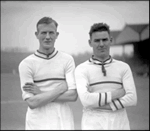 Lee Gauntlett has discovered that Aston Villa wore blue shirts in the FA Cup against Arsenal in January 1931 who wore white, while Roger Pashby has found this photograph from 1933 that definitively shows the light blue bands on Villa's heavy, woollen change jersey.
Lee Gauntlett has discovered that Aston Villa wore blue shirts in the FA Cup against Arsenal in January 1931 who wore white, while Roger Pashby has found this photograph from 1933 that definitively shows the light blue bands on Villa's heavy, woollen change jersey.
After going through my own source material I realised that there were numerous errors, which, in my defence, arose because many of the photographs I was working from were of poor quality. These have now been removed and I think the record for 1900-1939 is now pretty sound.
Meanwhile Tony Sealey has scanned the British Newspaper Archive and confirmed that Swansea Town wore white knickers throughout the 1930s and Nik Yeomans has submiited photographic evidence to corroborate this for 1934-35 and 1935-36 as well as provide evidence of the socks worn in these two seasons.
 Senior Scottish Elf, Alick Milne has submitted new evidence about the colours of the four clubs that amalgamated to form the modern Aberdeen FC in 1903. This includes contemporary press cuttings and photographs from the Aberdeen FC Official Website, including this one of the original Aberdeen club from 1885.
Senior Scottish Elf, Alick Milne has submitted new evidence about the colours of the four clubs that amalgamated to form the modern Aberdeen FC in 1903. This includes contemporary press cuttings and photographs from the Aberdeen FC Official Website, including this one of the original Aberdeen club from 1885.
22 October
Within hours of seeing yesterday's piece about Swansea Town, HFK Elf Tony Sealey got in touch to confirm that the Swans wore white shorts at Vetch Field when they played Spurs in March 1931 and again in March 1932. We can now confirm that the black shorts worn in the team photograph posted yesterday were therefore not part of their regular playing strip. I am still looking for corroboration for the period 1932-1936.
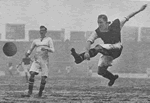 Lee Gauntlett has sent me a cutting that describes Aston Villa wearing jerseys that were "white with blue hoops" against West Ham United on 6 February 1932. The photograph of the corresponding match in January 1931 (a 5-5 thriller) shows Villa in similar tops but with a claret band.
Lee Gauntlett has sent me a cutting that describes Aston Villa wearing jerseys that were "white with blue hoops" against West Ham United on 6 February 1932. The photograph of the corresponding match in January 1931 (a 5-5 thriller) shows Villa in similar tops but with a claret band.
(Photograph West Ham United FC)
 Taken in April 1933 when Villa visited the Arsenal, this image shows the same jerseys that were worn in 1930-31. Because the quality of both images is poor, it is very hard to make out the light blue bands but after enhancing both pictures with my graphics software I was just able to make them out. It's my opinion that these jerseys were worn throughout 1930-33 and that the journalist quoted above just missed out (or his sub-editor removed) a reference to the claret band.
Taken in April 1933 when Villa visited the Arsenal, this image shows the same jerseys that were worn in 1930-31. Because the quality of both images is poor, it is very hard to make out the light blue bands but after enhancing both pictures with my graphics software I was just able to make them out. It's my opinion that these jerseys were worn throughout 1930-33 and that the journalist quoted above just missed out (or his sub-editor removed) a reference to the claret band.
While we're on the subject of Aston Villa, Richard Henman recalls watching them in a League Cup match at Exeter City in August 1977 wearing a mash up of blue shirts with yellow trim, light blue shorts and socks. Apparently Villa had brought their white and blue away strip not realising that the Grecians had changed to all 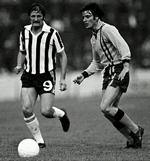 white that season. Should have checked their Rothman's. You can watch footage of the match here on the BFI website.
white that season. Should have checked their Rothman's. You can watch footage of the match here on the BFI website.
In 1978 Motherwell organised a competition for younger supporters to design their strip for the 1978-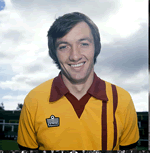 79 season. The winning design, produced by Admiral, featured a large flappy collar with claret and white stripes. In September these were replaced by shirts with plain collars but with the team heading towards relegation, the new design was dropped and the shirts from the previous season were reintroduced in February. This did not improve their fortunes and 'Well went down at the end of the season.
79 season. The winning design, produced by Admiral, featured a large flappy collar with claret and white stripes. In September these were replaced by shirts with plain collars but with the team heading towards relegation, the new design was dropped and the shirts from the previous season were reintroduced in February. This did not improve their fortunes and 'Well went down at the end of the season.
(Photographs and background provided by Willie Kay.)
21 October - Historical Miscellany
 Some time ago Gordon Hulmes sent me this photograph of Swansea Town taken in 1931-32 when his grandfather played for the team. The players are wearing black shorts but as it was not taken on a match day we cannot be certain that this was their regular strip. This led me to revisit to the excellent swans100 website where I found a lot of new material that fills in a many gaps in the record. While I now have strong evidence that the Swans wore black shorts in the early 1950s, there is a gap between 1929 and 1937 so I have not been able to corroborate this entry. I would really appreciate help from the HFK Elves on this one!
Some time ago Gordon Hulmes sent me this photograph of Swansea Town taken in 1931-32 when his grandfather played for the team. The players are wearing black shorts but as it was not taken on a match day we cannot be certain that this was their regular strip. This led me to revisit to the excellent swans100 website where I found a lot of new material that fills in a many gaps in the record. While I now have strong evidence that the Swans wore black shorts in the early 1950s, there is a gap between 1929 and 1937 so I have not been able to corroborate this entry. I would really appreciate help from the HFK Elves on this one!
Nick from the splendid upthemaggies website has been in touch to confirm that Notts County were still refered to as "the chocolate and light blues" in the local press during 1889-90. The royal blue shorts worn at Preston North End (reported in the Athletic News 3 March 1890) are therefore an anomoly. There was no reason for County to change their colours (Preston wore white by this time) so I can only speculate that the Lancashire & Yorkshire Railway mislaid their kit hamper en route forcing the team to borrow a set of kit on arrival.
Thanks to Graham Burton, I've added a passage in the Barnsley section explaining the origin of the name of their ground, Oakwell. Workington 1974-75 crest corrected. Berwick Rangers (1990-91, 1991-92, 1992-94 dates and detailing amended). Stockport County (1964-65 crest added).
20 October - International Update
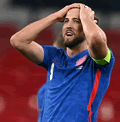 I've added England's new strips to the archive. Here we have Harry Kane expressing a degree of disappointment as his team lost 1-0 to Denmark and had two players sent off last month. I have just one thing to say to the people at Nike and the FA who decided to introduce a blue change strip - Belo Horizonte 29 June 1950.
I've added England's new strips to the archive. Here we have Harry Kane expressing a degree of disappointment as his team lost 1-0 to Denmark and had two players sent off last month. I have just one thing to say to the people at Nike and the FA who decided to introduce a blue change strip - Belo Horizonte 29 June 1950.
Northern Ireland wore an all-white strip against Austria earlier this month.
Week Ending 17 October - 2020-21 Update
EFL Former Members: Aldershot Town (shorts/socks confirmed), Barnet*, Yeovil Town, Boston United, Hartlepool United, Kidderminster Harriers, Torquay United, York City.
SPFL Update: Alloa Athletic, Annan Athletic, Arbroath, Brechin City, Edinburgh City*, Forfar Athletic, Greenock Morton, Peterhead*, Stenhousemuir*.
Former SPFL Members: Berwick Rangers (sponsorship added).
*Unchanged.
And that, aside from one or two sponsorship details still to be announced, wraps it up for the 2020-21 season. Next week I'll resume work on historical material.
Week Ending 3 October
 Earlier this month Macclesfield Town were wound up in the Insolvency & Companies Court. The club's owner, Amar Alkadi had asked for a further eight-week adjournment but Judge Sebastian Prentis declined, noting that the case had already been adjourned 12 times since it was started in January 2019. Alkadi had been given "ample time" to pay off the club's creditors, he said. In the interim, the club was penalised 17 points by the EFL for repeated late payment of their players and failing to fulfill two of their fixtures.
Earlier this month Macclesfield Town were wound up in the Insolvency & Companies Court. The club's owner, Amar Alkadi had asked for a further eight-week adjournment but Judge Sebastian Prentis declined, noting that the case had already been adjourned 12 times since it was started in January 2019. Alkadi had been given "ample time" to pay off the club's creditors, he said. In the interim, the club was penalised 17 points by the EFL for repeated late payment of their players and failing to fulfill two of their fixtures.
It is a scandal that the EFL and the FA continue allow incompetant, greedy and predatory owners to drive clubs into the ground. What makes this even more appalling is that the EFL has been sitting on proposals to tighten up their Owners' and Directors' Test since July 2018. After Bury were expelled from the EFL in August 2019 I wrote "it is only a matter of time before history repeats itself."
The photograph shows the Silkmen in happier times, 1969-70, when the team went on to win the FA Trophy.
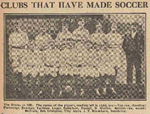 Tony Sealey found this photograph of the 1902-03 Blackburn Rovers team in The Sunday Pictorial (3 November 1929). This nicely fills a gap in the record for the early 20th century. While the shirts look plain white, this is an illusion caused by our old nemesis, orthographic film stock.
Tony Sealey found this photograph of the 1902-03 Blackburn Rovers team in The Sunday Pictorial (3 November 1929). This nicely fills a gap in the record for the early 20th century. While the shirts look plain white, this is an illusion caused by our old nemesis, orthographic film stock.
(Cutting from the National Newspaper Archive.)
Dundee (2019-20 shorts corrected): Stockport County (1991-92, 1992-93, 1998-99 detailing added/altered): Crawley Town (1996-97 added): Bury (1956-58 crest added): Nottingham Forest (1947-48 added): New Brighton (1924-28 corrected, 1927-38 socks amended): Bolton Wanderers (2002 anniversary kit stripes amended): Millwall (1975-77 warm & cold weather shirts now presented, authentic 1994 crest added): Cheltenham Town (1993-95 added): Gillingham (1980-81 collar corrected): Crawley Town (1998-99 shorts/socks confirmed): Salford City (1997-98 added): Burnley (2000-01, 2001-02 drop-sleeve detail added):
Week Ending 26 September - 2020-21 Update
Scottish Championship: Raith Rovers, Dunfermline Athletic, Heart of Midlothian, Inverness Caledonian Thistle, Queen of the South.
Scottish League One: Falkirk, Clyde, Cove Rangers, Dumbarton, Airdrieonians, East Fife, Montrose*, Partick Thistle.
Scottish League Two: Stranraer, Elgin City, Cowdenbeath, Albion Rovers, Queen's Park, Stirling Albion*.
Former Members: Berwick Rangers, East Stirlingshire.
*Unchanged.
Historical Miscellany
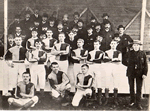 Bernard Gallagher recently sent me this early photograph of West Bromwich Albion. This appeared in a report on the FA Cup Final replay in the Blackburn Standard on April 10 1886 but since the match was played on that day, it cannot be of the team that appeared in the replay. The process of developing a photographic plate and preparing it for reproduction in a newspaper could not have been completed in just a few hours. In fact it is an archive photograph dating from 5 September 1885 when Albion still wore cardinal red and light blue jerseys. They changed to navy and white stripes shortly afterwards. I originally found this in The A-Z of West Bromwich Albion (Tony Matthews 1996).
Bernard Gallagher recently sent me this early photograph of West Bromwich Albion. This appeared in a report on the FA Cup Final replay in the Blackburn Standard on April 10 1886 but since the match was played on that day, it cannot be of the team that appeared in the replay. The process of developing a photographic plate and preparing it for reproduction in a newspaper could not have been completed in just a few hours. In fact it is an archive photograph dating from 5 September 1885 when Albion still wore cardinal red and light blue jerseys. They changed to navy and white stripes shortly afterwards. I originally found this in The A-Z of West Bromwich Albion (Tony Matthews 1996).
That was in the early days of HFK, before we had an army of research elves and when I could not afford to buy many books. At the time my work took me around the country so I contrived to have time to call in on libraries and book shops around the UK. On a trip to HMP Reading, for example, I was able to track down a copy of the Official History of Reading FC 1871-2003 in WH Smith.
I remember studying Tony Matthews' book in the Birmingham branch of Waterstones when a young shop assistant approached me and politely but firmly explained that I was welcome to browse the stock but sitting down with books and making notes was not allowed and perhaps I would like to leave.
Elgin City (1933-1914 knickers corrected, hooped 1909-10 kit removed - this was a change kit in yellow and black - gaps in the record 1969-76 now filled): Gillingham (2013-14 correct manufacturer's logo applied): Bradford City (1962- 63): Accrington Stanley (1990-91, 1991-92 shorts & socks now confirmed).
63): Accrington Stanley (1990-91, 1991-92 shorts & socks now confirmed).
Port Vale (1909-10, 1912-14 trim altered, 1929-30, 1934-36, December 1979 added, 1965-66 shirt trim added, 1981-82, 1982-83 sponsor altered). (Material and photograph sourced from onevalefan.co.uk)
Scotland 1905
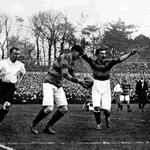 Greger Lindberg found an interesting item in the Scottish Referee (24 March 1905). An unnamed sportswear manufacturer wrote, "As showing the superior quality of our football jerseys, we have again been favoured with instructions from the Scottish Football Association to supply jerseys for the great international matches - Scotland v England (primrose and pink), Scotland v Ireland (marone [sic]), Scotland v Wales (royal blue)." The photograph shows the match against England.
Greger Lindberg found an interesting item in the Scottish Referee (24 March 1905). An unnamed sportswear manufacturer wrote, "As showing the superior quality of our football jerseys, we have again been favoured with instructions from the Scottish Football Association to supply jerseys for the great international matches - Scotland v England (primrose and pink), Scotland v Ireland (marone [sic]), Scotland v Wales (royal blue)." The photograph shows the match against England.
(Photograph FIFA. Press cutting the British Newspaper Archive.)
Week Ending 19 September - 2020-21 Update
League Two: Salford City.
That wraps it up for the Premier League and EFL apart from some former members. I'll tackle those once the SPFL section is complete.
Scottish Premiership: Hibernian, Kilmarnock, Livingston, Motherwell, Rangers, Ross County, St Johnstone, St Mirren.
Scottish Championship: Ayr United, Dundee.
Week Ending 12 September - 2020-21 Update
Premier League: Southampton (new sponsor added), Tottenham Hotspur (socks updated), Fulham.
Championship: Bristol City, Blackburn Rovers, Brentford, Swansea City, Queen's Parek Rangers.
League One: Hull City, Fleetwood Town, AFC Wimbledon (socks confirmed), Lincoln City, Bristol Rovers (socks updated), Charlton Athletic, Doncaster Rovers (socks confirmed), Gillingham*, Wigan Athletic.
League Two: Morecambe, Harrogate Town, Forest Green Rovers*, Crawley Town (socks confirmed), Exeter City, Leyton Orient, Newport County, Stevenage (shorts & socks confirmed).
Former Members: Stockport County, Wrexham (socks confirmed).
Scottish Premiership: Aberdeen, Celtic, Dundee United, Hamilton Academical.
*Unchanged.
Week Ending 29 August - More on the New Boys
Harrogate Town (1964-65, 1998-99 added, 1977-78 socks corrected).
The Barrow section has had a major update with with eight new graphics, stockings 1920-31 altered and missing detailing added to numerous graphics.
2020-21 Update
Premier League: Leeds United.
Championship: Luton Town, Preston North End, Cardiff City, Coventry City.
League One: Portsmouth, Milton Keynes, AFC Wimbledon, Oxford United.
League Two: Southend United.
Former members: Notts County.
Week Ending 22 August - Harrogate Town Update
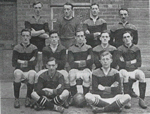 With the help of Sam Walsh and Phil Harrison I have been able to add no fewer than 27 new graphics to the Harrogate Town section and added detailing to several more. Our kit history now extends back to the formation of the original Harrogate AFC in 1919, pictured left.
With the help of Sam Walsh and Phil Harrison I have been able to add no fewer than 27 new graphics to the Harrogate Town section and added detailing to several more. Our kit history now extends back to the formation of the original Harrogate AFC in 1919, pictured left.
(Photograph Phil Harrison)
2020-21 Update
Premier League: Burnley.
Championship: Huddersfield Town, Birmingham City, Stoke City, Derby County, Nottingham Forest, Reading, Millwall (shorts detailing corrected), Sheffield Wednesday.
League One: Peterborough United, Swindon Town, Shrewsbury Town, Rochdale.
League Two: Crawley Town, Port Vale.
Former members: Wrexham.
15 August - 2020-21 Update
 My congratulations go to Harrogate Town who recently won promotion to League Two via the play-offs and whose recent kit record is now available on HFK. Pictured here is the Sulphurites team from 1956-57, currently the only confirmed strip we have prior to 1985 but I hope to rectify this shortly.
My congratulations go to Harrogate Town who recently won promotion to League Two via the play-offs and whose recent kit record is now available on HFK. Pictured here is the Sulphurites team from 1956-57, currently the only confirmed strip we have prior to 1985 but I hope to rectify this shortly.
(Photograph Phil Harrison Official Club Historian.)
Premier League: Everton (socks corrected).
Championship: Wycombe Wanderers, Norwich City, Watford.
League Two: Stevenage, Barrow.
11 August - 2020-21 Update
Premier League: Aston Villa, Crystal Palace.
Championship: Barnsley.
League One: Burton Albion.
Former members: Dagenham & Redbridge.
7 August - 2020-21 Update
Premier League: West Ham United.
League One: Sunderland, Ipswich Town.
League Two: Bolton Wanderers, Oldham Athletic, Scunthorpe United, Walsall.
6 August - 2020-21 Update
The 2020-21 Premier League/EFL gallery is now open.
Premier League: Wolverhampton Wanderers, Sheffield United, West Bromwich Albion, Tottenham Hotspur, Southampton.
Championship: Rotherham United.
League One: Doncaster Rovers, Plymouth Argyle.
League Two: Grimsby Town, Cheltenham Town (shorts/socks confirmed), Tranmere Rovers.
4 August - 2020-21 Update
The latest additions: Everton, Leicester City, Liverpool, Manchester City, Manchester United, Middlesbrough, Millwall, Newcastle United, Northampton Town.
31 July - 2020-21 Update
Chelsea, Cheltenham Town, Chesterfield, Colchester United, Crewe Alexandra.
28 July - 2020-21 Updates
I have begun to add the new kit graphics for 2019-20 and wil initially be working through these in alphabetical order. As previously announced, I shall only be adding first-choice kits.
Accrington Stanley, Aldershot Town, Arsenal, Blackpool, AFC Bournemouth, Bradford City, Brighton & Hove Albion, Bristol Rovers, Cambridge United, Carlisle United.
23 July - Bits 'n' Bobs
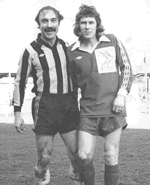 Pictured here are Jimmy Greaves in his Barnet days and Terry Paterson of Cheltenham Town probably taken in March 1978. The previous June the FA had bowed to pressure from clubs and permitted shirt sponsorship and the Robins are wearing a very early example.
Pictured here are Jimmy Greaves in his Barnet days and Terry Paterson of Cheltenham Town probably taken in March 1978. The previous June the FA had bowed to pressure from clubs and permitted shirt sponsorship and the Robins are wearing a very early example.
(Photograph supplied by James Fenn.)
Scotland (1901 v Wales), Shrewsbury Town (1911-12), Millwall (1889-92 added).
22 July - Victorian Spurs
 Our Tottenham Hotspur Elves, Tony Sealey and Richard Essen have been looking into early minute books with the help of a club historian and author and made some very interesting finds:
Our Tottenham Hotspur Elves, Tony Sealey and Richard Essen have been looking into early minute books with the help of a club historian and author and made some very interesting finds:
- It seems that the Maltese Cross that can (just about) be made out in this 1885-86 photograph was only worn in cup games.
- Between 1886 and 1889 Spurs wore mid-blue and white tops (presumed to be halved) and once again a special badge was added for cup matches in 1887-88.
- The strip recorded simply as "navy and white" for 1889-1890 is now confirmed to have been white shirts with dark blue britches.
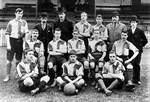 It has long been thought that the Cobblers' original colours were chocolate and light blue but we can now reveal that this is not correct. Tim Hickling, who is researching the early history of the club in the local newspaper archives, has found three references dating from 1897 to 1899 that confirm that the team wore claret and white from their formation.
It has long been thought that the Cobblers' original colours were chocolate and light blue but we can now reveal that this is not correct. Tim Hickling, who is researching the early history of the club in the local newspaper archives, has found three references dating from 1897 to 1899 that confirm that the team wore claret and white from their formation.
(Photograph Northmpton Town FC.)
 On 22 May I published a cutting from the Birmingham Daily Post that described the shirts worn by Wolverhampton Wanderers in the FA Cup final as "yellow and purple." It now appears that the reporter was mistaken. Simon Monks has found reports in no fewer than five newspapers that describe their shirts as "amber and black." It was not unusual at the time for provincial papers to simply lift copy from their rivals so it is possible for mistakes to get repeated but in this case at least two of the reporters were definitely at the match. Perhaps the Post reporter was confused by the appearance of Wolves' brand new shirts in the bright sunlight.
On 22 May I published a cutting from the Birmingham Daily Post that described the shirts worn by Wolverhampton Wanderers in the FA Cup final as "yellow and purple." It now appears that the reporter was mistaken. Simon Monks has found reports in no fewer than five newspapers that describe their shirts as "amber and black." It was not unusual at the time for provincial papers to simply lift copy from their rivals so it is possible for mistakes to get repeated but in this case at least two of the reporters were definitely at the match. Perhaps the Post reporter was confused by the appearance of Wolves' brand new shirts in the bright sunlight.
I have revised the Arsenal records for the Plumstead era thanks to material shared with HFK by Andy Kelly and Mark Andrews. This has resulted in some tweaks to dates for first choice kits and a comprehensive overhaul of the change kit section.
21 July - Barrow AFC Update
Over the past fortnight I have been occupied with updating Barrow's kit record covering the 48 years since they lost their place in the Football League. With the 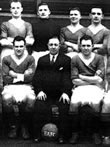 help of Peter Naylor and several of his chums involved i the club's fan forum, Ihave been able to make considerable progress and the record is now up to date. There are, however, still some gaps in the 1970s and early 1980s that need to be filled and quite a few of the kits from the past two decades are missing important details (noted below the graphics). All help will be gratefully received.
help of Peter Naylor and several of his chums involved i the club's fan forum, Ihave been able to make considerable progress and the record is now up to date. There are, however, still some gaps in the 1970s and early 1980s that need to be filled and quite a few of the kits from the past two decades are missing important details (noted below the graphics). All help will be gratefully received.
In the 1930's and 40's the team's signature blue shirts featured a large blue chevron (a look that has yet to be revived) but for the 1934-35 season, a large white V neck was worn, a very unusual design for the period.
8 July- 2020-21 Update
As many regular visitors have assumed, I am holding off from adding the new 2020-21 strips until all the remaining promotion and relegation issues have been resolved in England.
As I wrote on 31 March, I am reviewing my current workload and have decided that I will no longer add second, third and one-off kits to the season sections, which will now revert to a single consolidated page showing first choice strips for all the top tiers in England and Scotland. I realise that this will come as a disappointment to many visitors who look forward to these updates each season and I will greatly miss writing snarky comments about each new folly but the work involved in drawing so many increasingly intricate designs is no longer sustainable. This will, however, ensure that I have capacity to cover the Euros when they (I hope) go ahead next year.
The Future of the Canarinho
Back in May, when we were looking into the reasons behind Brazil's odd choice of grey socks for some matches in the 1970 World Cup, our Brazil Elf, Gabriel Vogas mentioned to me how the supporters of the country's far-right president, Jair Bolsonaro, had co-opted the iconic canary yellow shirt of the national football team as well as the Brazilian flag as emblems in support of their 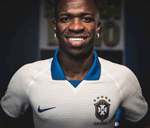 extremist views. This topic was covered in today's Guardian.
extremist views. This topic was covered in today's Guardian.
The issue has divided the Brazilian public. Many on the political left are outraged that the Bolsonaristas have pre-empted these iconic national symbols during anti-democratic rallies and protests against social distancing and have called for the Brazilian Football Confederation (CBF) to return to the white and blue colours worn up until 1950 and  revived for the 2019 Copa America (left).
revived for the 2019 Copa America (left).
Not all progressives agree, however. Rather than retire the famous yellow shirt, leading journalist Juca Kfouri and a top newspaper, Folha de São Paulo, have called for moderates and leftists to reclaim these treasured national symbols. Surrendering them to the far-right, they argue, would represent a victory for the Bolsonaristas.
The Canarinho shirt was designed in 1950 by Aldyr Garcia Schlee, then aged 19, (pictured right in 2007) following Brazil's disastrous defeat in the 1950 World Cup final. Schlee, who passed away in 2018, was appalled at the way far-right parties had co-opted the iconic shirt he had designed and, following the impeachment of Brazil's president, Dilma Rousseff (from the social democrat Workers' Party) in 2016, a process widely regarded by the international comunity as driven by a right-wing conspiracy, he wrote: "The jersey itself has become a symbol of the coup in this country...The whole wave of cheap moralism of the worst kind...served to support, feed and define the coup in the name of a jersey that I (now) detest." In a separate blog Schlee wrote, "I don't want anything to do with it any more. I abdicate any relation about making it. Wear another colour. Preferably brown, the colour of shit."
(Photographs: Pedro Martins/Nike/EPA, Gilbert Perrin/The Football Museum.)
New Affiliate Partners
I'm pleased to announce that HFK is now partnered with Arsenal Direct and the official West Ham United online store. You can now buy official merchandise by clicking on the crest at the top of the respective club pages and through the Sponsored Links on this page. HFK receives a commission on sales generated in this way.
After an absence of 48 years it was confirmed last month that Barrow are to be promoted to League Two. I've started on the mammoth task of filing in the huge gap in our records since 1972 and all offers of help will be appreciated!
18 June - A Victorian Miscellany
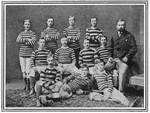 I've been taking another look at the evidence for Stoke's earliest colours prompted by an e-mail from Sam Booden who has found a previously unrecorded kit for 1871-72. Examining Robin Horton's notes from CW Alcock's Football Annuals I see that their colours for 1873 are recorded as crimson and blue. There is an infuriating gap before the next entry for 1879, which
I've been taking another look at the evidence for Stoke's earliest colours prompted by an e-mail from Sam Booden who has found a previously unrecorded kit for 1871-72. Examining Robin Horton's notes from CW Alcock's Football Annuals I see that their colours for 1873 are recorded as crimson and blue. There is an infuriating gap before the next entry for 1879, which  gives us blue and black. I've come to the conclusion that the 1877-78 team (left) is wearing hoops of crimson and light blue while the 1882-83 side (right) is in light blue and black.
gives us blue and black. I've come to the conclusion that the 1877-78 team (left) is wearing hoops of crimson and light blue while the 1882-83 side (right) is in light blue and black.
(Photographs Stoke City FC: Images of Sport [Tony Matthews] 1999)
Robin Horton has uncovered some very early colours from the 1864 FA Minute Book, less than 12 months after the Football Association was formed and there were only a handful of members.
Barnes (1864), Crusaders (1864), Lincoln (1864), Forest School (1864).
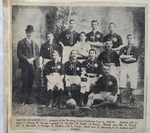 Some more colours have come to light for the following decade: All Saints Shrewsbury (1877), South Reading (1888 left), South Bank (1880 jersey corrected), Hanover United (1880 shirt corrected).
Some more colours have come to light for the following decade: All Saints Shrewsbury (1877), South Reading (1888 left), South Bank (1880 jersey corrected), Hanover United (1880 shirt corrected).
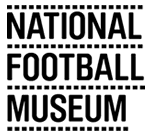 (South Reading photograph Chris Lee The Biscuitmen)
(South Reading photograph Chris Lee The Biscuitmen)
If you have few moments to spare I should like to direct you to The National Football Museum website where a short article by yours truly awaits your reading pleasure.
10 June - Mixed Stuff
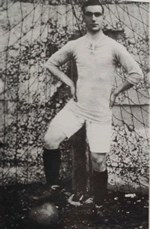 Following on from my piece about Norwich City last week, Nick Hayhoe has sent me this photograph of Cecil Potter in his Norwich strip dating from 1914-15. Nick confirms that despite going in to voluntary liquidation in December 1917, the team continued to play fixtures against sides from the armed services and others throuout 1918-19, including fundraisers for the Hospital Cup which is probably the trophy on display in the team photograph posted on 2 June.
Following on from my piece about Norwich City last week, Nick Hayhoe has sent me this photograph of Cecil Potter in his Norwich strip dating from 1914-15. Nick confirms that despite going in to voluntary liquidation in December 1917, the team continued to play fixtures against sides from the armed services and others throuout 1918-19, including fundraisers for the Hospital Cup which is probably the trophy on display in the team photograph posted on 2 June.
Maidstone United (1983-84 added), Aston Villa (1900-01 change added), Morton (1976-77 broad hooped kit added), West Ham United (in November 1924 the team switched back to claret jerseys with blue sleeves after wearing the same colours reversed from the start of the season), St Johnstone (1967-69 added), Cardiff City (1988-89, 1989-90 detailing added).
2 June - Norwich City Update
 I've made a few tweaks to the Norwich City section including adding a graphic for this rather poor quality photograph purporting to show the 1918-19 team. This is rather odd as the club had gone into voluntary liquidation in December 1917 and was not re-launched until February 1919. I assume this team played a few friendly matches before the season ended and they rejoined the Southern League. (1919 added, 1909-10 now correctly dated, 1927-47 graphics tweaked, 1972-73 early season version without badge added, 1985 League Cup Final added).
I've made a few tweaks to the Norwich City section including adding a graphic for this rather poor quality photograph purporting to show the 1918-19 team. This is rather odd as the club had gone into voluntary liquidation in December 1917 and was not re-launched until February 1919. I assume this team played a few friendly matches before the season ended and they rejoined the Southern League. (1919 added, 1909-10 now correctly dated, 1927-47 graphics tweaked, 1972-73 early season version without badge added, 1985 League Cup Final added).
1 June
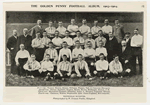 Tony Sealey and Richard Essen have uncovered new evidence that Tottenham Hotspur wore black and white change shirts in 1899-1900 before switching to mid-blue and white stripes the following year. This remained their standard alternative until red shirts were adopted in 1904. The team photograph is from 1903-04 with the reserves in striped change shirts.
Tony Sealey and Richard Essen have uncovered new evidence that Tottenham Hotspur wore black and white change shirts in 1899-1900 before switching to mid-blue and white stripes the following year. This remained their standard alternative until red shirts were adopted in 1904. The team photograph is from 1903-04 with the reserves in striped change shirts.
(Photograph The Golden Penny Football Album 1903-04.)
Crystal Palace (1936-37 added), Darlington (1920-21 added), Everton (1949-50, 1953-54 added), Halifax Town (1932-33, 1938-39 added), Hartlepools United (1908-11 revised, 1952-53 added), Hereford United (1948-49 revised, 1954-55 added).
29 May
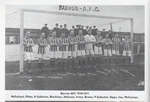 This is the Barrow team from 1910-11 wearing previously unrecorded striped jerseys. I've provisionaly rendered these as light blue and black but this has yet to be confirmed. (1908-09, 1910-11 added). Supporters in the Furness area are anxiously waiting to find out if their team, who were top of the National League when fixtures were suspended, will be promoted to League Two to fill the vacancy created by Bury's expulsion.
This is the Barrow team from 1910-11 wearing previously unrecorded striped jerseys. I've provisionaly rendered these as light blue and black but this has yet to be confirmed. (1908-09, 1910-11 added). Supporters in the Furness area are anxiously waiting to find out if their team, who were top of the National League when fixtures were suspended, will be promoted to League Two to fill the vacancy created by Bury's expulsion.
(Photograph Barrow AFC The First Hundred Years.)
Lincoln City (1997-98 socks corrected), Notts County (1889-90 added),
28 May - More on Brazil's 1970 Grey Socks
 There is a theory circulating on social media that Zagalo, Brazil's coach in 1970 chose the grey socks worn twice in the 1970 World Cup because they were worn by Botafogo when he was their coach but there is no evidence to back this up. A far more likely explanation is offered by John Lovett who points out that Felix, the Brazilian goalkeeper, always wore grey socks with his dark blue jersey and shorts, as in this photograph taken before the final. There were three goalkeepers in the squad so assuming they had brought sufficient kits for the entire tournament they would certainly have had enough grey socks to go round the rest of the team.
There is a theory circulating on social media that Zagalo, Brazil's coach in 1970 chose the grey socks worn twice in the 1970 World Cup because they were worn by Botafogo when he was their coach but there is no evidence to back this up. A far more likely explanation is offered by John Lovett who points out that Felix, the Brazilian goalkeeper, always wore grey socks with his dark blue jersey and shorts, as in this photograph taken before the final. There were three goalkeepers in the squad so assuming they had brought sufficient kits for the entire tournament they would certainly have had enough grey socks to go round the rest of the team.
Random Stuff
Darlington (1969-70 added), Crystal Palace (1999-2000, 2000-01, 2001-02 detailing added, 1999-2000 shirt sponsors added), Sheffield Wednesday (1989-90, 1990-91, 1991-93 watermarks revised, 1991 League Cup Final kit added).
Soviet Union (1968 socks corrected).
26 May - Brazil 1970 World Cup
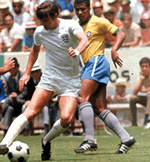 Last week Gareth Rogers wrote to me to ask why Brazil wore grey socks in their games against England and Peru in the 1970 World Cup? Obviously, he wrote, it was to avoid a colour clash with their opponents but why did they not wear the blue socks from their change strip?
Last week Gareth Rogers wrote to me to ask why Brazil wore grey socks in their games against England and Peru in the 1970 World Cup? Obviously, he wrote, it was to avoid a colour clash with their opponents but why did they not wear the blue socks from their change strip?
Having no answer to Gareth's question I turned to our Brazil Elf, Gabriel Vogas, who did not disappoint.
"I really have a long research about Brazilian kit evolution and those grey socks have got my attention. But, sorry to disapoint you and your friend, I never found an answer to "why grey". But I sure can contribute showing the way to a very plausible explanation.
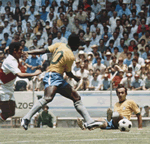 "The Brazilian Football Confederation (CBD and later CBF) was always very conservative (about) Brazil's kit. Even to this day, we never had an official third color (jersey or even shorts and socks, to avoid that terrible yellow-white-white that is pejoratively knicknamed here "the fried egg" combination). Since 1958, when blue officialy became the away jersey (between the creation of the yellow jersey and the final against Sweden, white was used as the away opition), it always has been yellow with green trim over blue over white, or blue over white over... and here is the point. For many years, the CBF was so conservative that Brazil didn't have away socks, only white ones. The first time the blue socks appeared was in WC 1990, as you can easily see in your WC kit history.
"The Brazilian Football Confederation (CBD and later CBF) was always very conservative (about) Brazil's kit. Even to this day, we never had an official third color (jersey or even shorts and socks, to avoid that terrible yellow-white-white that is pejoratively knicknamed here "the fried egg" combination). Since 1958, when blue officialy became the away jersey (between the creation of the yellow jersey and the final against Sweden, white was used as the away opition), it always has been yellow with green trim over blue over white, or blue over white over... and here is the point. For many years, the CBF was so conservative that Brazil didn't have away socks, only white ones. The first time the blue socks appeared was in WC 1990, as you can easily see in your WC kit history.
"So, Brazil didn't have an away pair of socks and Fifa didn't allowed a sock-clash in 1970 (they allowed clashes numerous times before and after, see the same clash against Peru in 1978). The big question is: if Brazil had to change, why grey? Well, firstly, it wasn't blue because Brazil didn't have blue socks back then. That leaves us with two scenarios: it was improvised merely by chance or it was chosen because it did not change the overall look of the kit (I think most people never even realized Brazil ever played in grey socks). I really support the latter."
Our chums at 3RETRO have added a number of replica shirts to their catalogue which you may want to seek out. Newcastle United (1993-95 change), Arsenal (1982-83 change, 1985-86 centenary change), Brighton & Hove Albion (1977-78, 1980-83, 1983 FA Cup Final, 1999-2000), Burnley (1960-61, 1996-98), Chelsea (1961, 1962-63), Crystal Palace (1973-75, 1977-80, 1990 FA Cup Final), England (1986 World Cup, 2001-03), Norwich City (1976-81), Scotland (1967-71), Wolverhampton Wanderers (1960 FA Cup Final, 1988 Sherpa Van Trophy Final). Don't forget to enter 3RETRO10 at the checkout for your exclusive HFK discount.
22 May - A Bit of Victoriana
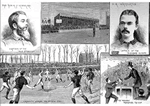 This engraving is of the 1883 FA Cup Final between Blackburn Olympic and Old Etonians and was the source I used to draw my graphics (dark blue for Olympic, white for Old Etonians). This seemed logical
This engraving is of the 1883 FA Cup Final between Blackburn Olympic and Old Etonians and was the source I used to draw my graphics (dark blue for Olympic, white for Old Etonians). This seemed logical 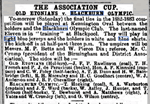 given the similarity of the tops worn by the two team, suggesting that both wore alternative tops. However, Brian Webb has uncovered this report from Sporting Life published on the eve of the match (30 March 1883) which states that Olympic "will play in light blue jerseys and the holders in white and blue shirts," that is to say their regular colours.
given the similarity of the tops worn by the two team, suggesting that both wore alternative tops. However, Brian Webb has uncovered this report from Sporting Life published on the eve of the match (30 March 1883) which states that Olympic "will play in light blue jerseys and the holders in white and blue shirts," that is to say their regular colours.
28 May Update: Graham Brack has found a post-match report in The Times (April 2 1883) that confirms Blackurn Olympic wore light blue.
 Even more remarkable is this find, also made by Brian, concerning the 1893 FA Cup Winners, Wolverhampton Wanderers. Everyone has always assumed that the
Even more remarkable is this find, also made by Brian, concerning the 1893 FA Cup Winners, Wolverhampton Wanderers. Everyone has always assumed that the 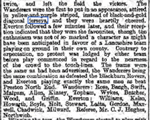 striped shirts worn in this match instead of their usual diagonal halves were old gold and black. However, this match report from the Birmingham Daily Post (27 March 1893) sheds an entirely different light on the matter.
striped shirts worn in this match instead of their usual diagonal halves were old gold and black. However, this match report from the Birmingham Daily Post (27 March 1893) sheds an entirely different light on the matter.
(Press cuttings & engraving from The National Newspaper Archive.)
Accrington (1883-84 added), Small Heath (1890-99 shirt colour and dates adjusted).
21 May - Pieces 'n' Bits
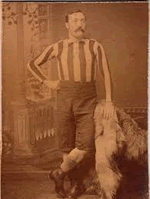 This photograph, taken in 1887, shows a Preston North End players posing in a red and white striped shirt. Vertical stripes were still a rarity at the time and this may be an early example from the Rothwell Hosiery Company in nearby Bolton who invented a new loom capable of weaving vertical stripes at around this time.
This photograph, taken in 1887, shows a Preston North End players posing in a red and white striped shirt. Vertical stripes were still a rarity at the time and this may be an early example from the Rothwell Hosiery Company in nearby Bolton who invented a new loom capable of weaving vertical stripes at around this time.
Northern Ireland wore black shorts when they met the Netherlands in a World Cup qualifier in April 1965. This may the first occasion that they wore a variant on the standard green and white strip.
Maidstone United (1926-27, 1947-48, 1958-59 added), Lincoln City (1987-89 corrected),
19 May - Bits 'n' Pieces
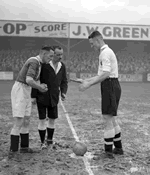 Scarborough (1929-31 socks confirmed, 1931-38 revised, 1974-75 short trim added). The Complete A-Z of Scarborough FC gives the team colours for 1931-38 as claret with a gold band. This photograph, from January 1938 at Luton Town, proves their jerseys in fact had a chevron.
Scarborough (1929-31 socks confirmed, 1931-38 revised, 1974-75 short trim added). The Complete A-Z of Scarborough FC gives the team colours for 1931-38 as claret with a gold band. This photograph, from January 1938 at Luton Town, proves their jerseys in fact had a chevron.
 Sheffield Wednesday (1946-47 trim corrected),Sheffield United (1934-35, 1960-61 added, 1946-47socks corrected), Southport Central (1916-17 confirmed - see photograph right), Exeter City (1934-36, 1936-37 socks amended), Accrington Stanley (two unrecorded variants aded to 1960-61), Brentford (1994-Feb 95 now has the correct badge applied).
Sheffield Wednesday (1946-47 trim corrected),Sheffield United (1934-35, 1960-61 added, 1946-47socks corrected), Southport Central (1916-17 confirmed - see photograph right), Exeter City (1934-36, 1936-37 socks amended), Accrington Stanley (two unrecorded variants aded to 1960-61), Brentford (1994-Feb 95 now has the correct badge applied).
15 May - Bobs 'n' Bits
 This is Abbey United in 1928-29 with a truckload of trophies from local competitions. They changed their name to Cambridge United in 1951, a signal of a new and more ambitious approach that eventually took them into the Football League. The photograph is from 100 Years of Coconuts which has a fine selection of team photographs that I've used to refresh the club section.
This is Abbey United in 1928-29 with a truckload of trophies from local competitions. They changed their name to Cambridge United in 1951, a signal of a new and more ambitious approach that eventually took them into the Football League. The photograph is from 100 Years of Coconuts which has a fine selection of team photographs that I've used to refresh the club section.
Clydebank (1977-78 corrected), Shrewsbury Town (1988-89 added, detailing tweaked on 1983-85, 1985-86, 1986-87, 1989-90 and crest history updated).
13 May - Bits 'n' Bobs
Thanks to Dave Wherry I have added a one-off Grimsby Town strip worn in the FA Cup in January 1963 to the record, added an unrecorded 1976-77 kit and tweaked detailing and dates for various graphics between 1985 and 2000.
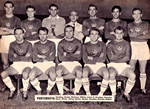 Our old chum Tony Sealey has finished rifling through his family's collection of Portsmouth memorabilia and provided a detailed account of the team's kit variations 1946-1967. Pictured here is the Pompey team from 1963 with the predominantly white socks they would wear against opponents wearing red stockings in both home and away matches.
Our old chum Tony Sealey has finished rifling through his family's collection of Portsmouth memorabilia and provided a detailed account of the team's kit variations 1946-1967. Pictured here is the Pompey team from 1963 with the predominantly white socks they would wear against opponents wearing red stockings in both home and away matches.
(Photograph Beyond the Last Man.)
Millwall (1994-96 collar corrected & detailing added), Leyton Orient (1946-47 added).
11 May - Are Crystal Palace the World's Oldest Football Club?
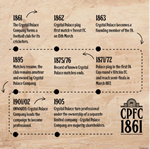 Last month Crystal Palace FC made the astonishing claim that they are the oldest football club in the world, dating back to 1861 illustrated by the fetching graphic shown here. The claim is based on Peter Manning's book, Palace at the Palace (available from Amazon) and I decided that before I form an opinion I should read the book.
Last month Crystal Palace FC made the astonishing claim that they are the oldest football club in the world, dating back to 1861 illustrated by the fetching graphic shown here. The claim is based on Peter Manning's book, Palace at the Palace (available from Amazon) and I decided that before I form an opinion I should read the book.
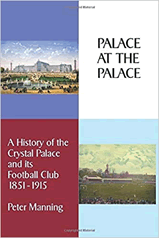 Essentially, Manning sets out to establish a link between the original, amateur Crystal Palace and the professional Crystal Palace formed in 1905. He argues that both the 1861 incarnation and the 1905 professional team were subsidiary businesses of the Crystal Palace Company, which took over management of the Great Exhibition buildings after they were moved from Hyde Park to Sydenham Hill in 1852. Although there was a hiatus between 1875 and 1895 during which no fixtures were played, Manning claims that the ownership of the parent company is proof of continuity, as is the fact that a Crystal Palace team played three games (only) between 1895 and 1897. He also suggests that because many of the players in the original side also played for the Crystal Palace Cricket Club who continued to play matches after 1875 then the football club continued to exist right up until 1905 when it became professional.
Essentially, Manning sets out to establish a link between the original, amateur Crystal Palace and the professional Crystal Palace formed in 1905. He argues that both the 1861 incarnation and the 1905 professional team were subsidiary businesses of the Crystal Palace Company, which took over management of the Great Exhibition buildings after they were moved from Hyde Park to Sydenham Hill in 1852. Although there was a hiatus between 1875 and 1895 during which no fixtures were played, Manning claims that the ownership of the parent company is proof of continuity, as is the fact that a Crystal Palace team played three games (only) between 1895 and 1897. He also suggests that because many of the players in the original side also played for the Crystal Palace Cricket Club who continued to play matches after 1875 then the football club continued to exist right up until 1905 when it became professional.
These seems to me to be tenuous claims indeed but one detail towards the end of the book struck me. Manning writes that in 1905 Chelsea FC and Crystal Palace FC both applied for affiiation to the FA at the same time. But according to his own thesis, Palace had been affiliated to the FA since 1861 so why were they 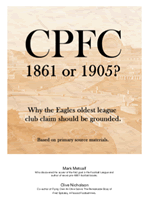 making a fresh application?
making a fresh application?
I then turned to a document written by Mark Metcalf and Clive Nicholson, two football historians with impeccable credentials (available here free of charge). Backed up with copious contemporaraneous references, the authors comprehensively demolish Manning's thesis and the claims of the club. For example:
* The Crystal Palace Cricket Club (formed 1857) and the Crystal Palace Football Club (1861) were not subsidiaries of the Crystal Palace Company but their tenants, paying rent for the use of the park.
* There are no records of Crystal Palace being affiliated to the FA after 1875, nor did they play any matches or receive any coverage in the press.
* The teams that played just three matches as Crystal Palace in 1895, 1896 and 1897 were made up primarily of Corinthians' players. There are no records of a Crystal Palace club being affiliated to the FA at the time even though the park now contained the largest football stadium in London.
* Attempts by the Crystal Palace Company to form a professional club in 1901-02 failed because the FA considered there would be a conflict of interest if the owner of the FA Cup Final venue also owned a professional football team.
* When Crystal Palace Football & Athletic Co Ltd was formed in 1905 it was as a separate company under the direction of an independent board and while the Crystal Palace Company invested heavily in shares, they did not control the new club.
So there we have it. I must say Manning's book is a good read with a lot of fascinating detail even if it suffers from trying to make the facts fit the conclusion so buy a copy by all means. But do also read Metcalf & Nicholson's rebuttal. It's a fine way to spend a couple of days in lockdown.
7 May
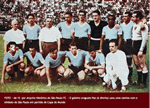 It appears that the story about the Uruguay team wearing the São Paulo club crest in the 1950 World Cup match against Spain is untrue. Our Brazilian Elf, Gabriel Vogas has provided the background to this myth. On the left is a colourised photograph of the South American side lining up before the game in question and standing on the right is the reserve goalkeeper, Anibal Paz, wearing a club top. His presence is a little odd as he was not selected for the match and I suspect this is an early example of photo-bombing.
It appears that the story about the Uruguay team wearing the São Paulo club crest in the 1950 World Cup match against Spain is untrue. Our Brazilian Elf, Gabriel Vogas has provided the background to this myth. On the left is a colourised photograph of the South American side lining up before the game in question and standing on the right is the reserve goalkeeper, Anibal Paz, wearing a club top. His presence is a little odd as he was not selected for the match and I suspect this is an early example of photo-bombing.
(Photograph São Paulo FC.)
While we are myth-busting, Phil Marriott, Biffa and Gavin Haigh have discovered that the yellow Newcastle United Umbro change strip with green trim ascribed to 1980-82 did not exist. In fact Toon's change strip between 1980 and 1983 was yellow with blue trimmings, worn without sponsorship in televised games.
30 April - 2019-20 Update
A few new kits were launched before all sports were suspended last month. Cheltenham Town (charity kit), Norwich City (3rd shorts detailing added), Bristol City (125th anniversary kit), Partick Thistle (2nd socks corrected).
International Update
Scotland (2nd), Northern Ireland (2nd), Republic of Ireland (1st, 2nd) added.
29 April
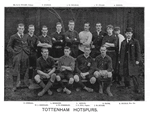 Thanks to Richard Essen and Tony Sealey I've revised some dates in Tottenham Hotspur's early kit history. In the course of his research, Richard discovered that during the period that the team wore red (1890-96) they kept a set of white shirts for use when colours clashed. This means that Spurs sometimes wore white
Thanks to Richard Essen and Tony Sealey I've revised some dates in Tottenham Hotspur's early kit history. In the course of his research, Richard discovered that during the period that the team wore red (1890-96) they kept a set of white shirts for use when colours clashed. This means that Spurs sometimes wore white 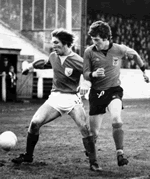 several years before this became their first choice in 1898. The team photograph is from 1894-95.
several years before this became their first choice in 1898. The team photograph is from 1894-95.
Brentford (1901-03 stripes corrected), Oxford United (1974-75 added), Scarborough (1999-2000 shorts & socks corrected), Alloa (1976-77 corrected), Caledonian (1976-77, 1983-84 added).
The photograph shows Alloa (black shorts) playing Caley in the 1976-77 Scottish Cup.
22 April
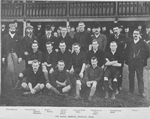 Today's photograph confirms that Royal Arsenal wore navy knickers in 1892-93. Note how dark their shirts appear, a typical example of the effect of orthographic film stock. It is photographs like this that gave rise to the (now disproved) notion that the Gunners wore dark red shirts during this period.
Today's photograph confirms that Royal Arsenal wore navy knickers in 1892-93. Note how dark their shirts appear, a typical example of the effect of orthographic film stock. It is photographs like this that gave rise to the (now disproved) notion that the Gunners wore dark red shirts during this period.
(Photograph Illustrated Sporting and Dramatic News found by Richard Essen.)
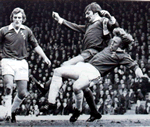 One of the side effects of the current lockdown is that the HFK Elves are beavering away unearthing litle gems for us. For example, Oldham Athletic wore Umbro strips throughout the Seventies but Tony Sealey has discovered that in the FA Cup tie against Liverpool on 26 February 1977, they wore this Bukta strip. Presumably this was a one-off but I have no idea what the story behind it is.
One of the side effects of the current lockdown is that the HFK Elves are beavering away unearthing litle gems for us. For example, Oldham Athletic wore Umbro strips throughout the Seventies but Tony Sealey has discovered that in the FA Cup tie against Liverpool on 26 February 1977, they wore this Bukta strip. Presumably this was a one-off but I have no idea what the story behind it is.
Reading (1905-06 added), Crystal Palace (1983-84, 1987-88, 1988-90 detailing fixed), Fulham (1984-85 colour of sponsorship corrected).
20 April
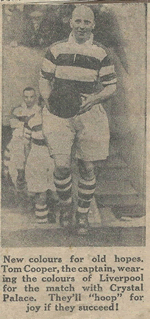 Regular visitors will know that the rules of the FA Cup used to require both teams to change when colours clashed. With this in mind, Liverpool bought a set of red and white hooped shirts for their FA Cup tie with Crystal Palace in January 1938. (Both sides had white change shirts at the time.) Pavel Shalaev has found this newspaper cutting showing Tom Cooper leading out the Liverpool team for the game. The hoops also appeared on New Years' Day at Chelsea, presumably as a try-out since no change was needed for this game.
Regular visitors will know that the rules of the FA Cup used to require both teams to change when colours clashed. With this in mind, Liverpool bought a set of red and white hooped shirts for their FA Cup tie with Crystal Palace in January 1938. (Both sides had white change shirts at the time.) Pavel Shalaev has found this newspaper cutting showing Tom Cooper leading out the Liverpool team for the game. The hoops also appeared on New Years' Day at Chelsea, presumably as a try-out since no change was needed for this game.
Cardiff City (2001-02 detailing added, 2002-03 two additional strips created), Bristol City (1973-76 the vee-neck and crew necks shirts worn in this period have been re-categorised as warm and cold weather strips). Maidstone United 1970-72 added, 1972-73 socks corrected).
According to the Sunderland Daily Echo (April 18 1898) Nottingham Forest wore black knickers rather than their usual navy in that year's FA Cup Final. Other contemporary newspaper articles found by Graham Brack indicate that Sunderland wore navy knickers between 1896 and 1899.
16 April
 This photograph is of Fergie Suter, the world's first professional player in his Darwen days, 1879-80. Peter Stevenson spotted that the letters "DFC" are embroidered onto his jersey. Closer examination of the team photograph from which this image is taken reveals that the rest of the team are wearing the same emblem.
This photograph is of Fergie Suter, the world's first professional player in his Darwen days, 1879-80. Peter Stevenson spotted that the letters "DFC" are embroidered onto his jersey. Closer examination of the team photograph from which this image is taken reveals that the rest of the team are wearing the same emblem.
(Photograph bbc.co.uk)
 Thanks to detailed notes sbmitted by Paul Burnham, I've revised the Norwich City section, re-colouring the graphics to present a more accurate rendition of canary yellow, adding detailing and revising the early crests. This photograph is of the 1913-14 team, which has a unique yoke although it is quite hard to make out. Also in evidence are an early version of the canary crest and the reserves clad in the old blue and white tops. I assume these were kept as a change kit.
Thanks to detailed notes sbmitted by Paul Burnham, I've revised the Norwich City section, re-colouring the graphics to present a more accurate rendition of canary yellow, adding detailing and revising the early crests. This photograph is of the 1913-14 team, which has a unique yoke although it is quite hard to make out. Also in evidence are an early version of the canary crest and the reserves clad in the old blue and white tops. I assume these were kept as a change kit.
(Photograph Hayward Kidd, Norwich)
Exeter City (1991-92 collar corrected), Coventry City (1907-09, 1909-10 changed).
7 April - Bits 'n' Bobs
Grimsby Town (1933-34 corrected, Sept 1934 socks changed and switch to red socks now correctly dated, alternate kits added for 1972-73, 1973-74, 1979-80, 1988-89 and various details have been tweaked on modern graphics). My thanks go to club historian, Dave Wherry, for all of this new material.
Wolverhampton Wanderers (2002-04 sponsor's logo fixed),
6 April - Alloa Athletic Update
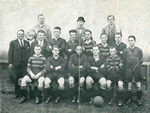 Officially Alloa Athletic's colours are gold and black although they have also been registered as orange and black in their formative years and between the wars. There seem to have quite a few variations over the last 50 years and since 1998, an attractive shade of deep amber has been preferred. I have revised the entire Alloa section to better reflect these colour variations and added some previously unrecorded crests. The photograph is of the 1929 team.
Officially Alloa Athletic's colours are gold and black although they have also been registered as orange and black in their formative years and between the wars. There seem to have quite a few variations over the last 50 years and since 1998, an attractive shade of deep amber has been preferred. I have revised the entire Alloa section to better reflect these colour variations and added some previously unrecorded crests. The photograph is of the 1929 team.
(Photograph The Alloa Advertiser.)
2 April - Scottish Update
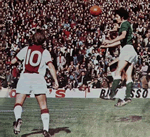 In the 1972-73 season Heart of Midlothian broke with tradition and adopted white shirts with a broad maroon stripe in the style of Ajax. This created a problem when Hearts visited Hibernian in September 1972 because the sleeves clashed. At the time it was the home team that changed when colours clashed in the Scottish League so Hibs wore a one-off shirt in plain green with white facings. For the return match Hearts played in familiar maroon shirts and Hibs in their usual green and white tops.
In the 1972-73 season Heart of Midlothian broke with tradition and adopted white shirts with a broad maroon stripe in the style of Ajax. This created a problem when Hearts visited Hibernian in September 1972 because the sleeves clashed. At the time it was the home team that changed when colours clashed in the Scottish League so Hibs wore a one-off shirt in plain green with white facings. For the return match Hearts played in familiar maroon shirts and Hibs in their usual green and white tops.
2015-16 detailing changes: Rangers (2nd, 3rd), Peterhead (2nd), St Mirren (1st, 2nd), Livingston (1st), Falkirk (1st, 2nd), Kilmarnock (1st, 2nd), Dundee (2nd), Hibernian (2nd), Ayr United (1st, 2nd), Airdrieonians (1st), Queen of the South (1st), Dumbarton (1st, 2nd), Greenock Morton (1st, 2nd). Information provided by Ian McConnel.
Raith Rovers (1971-72), East Stirlingshire (1965-66 corrected, 1974-75 added), Alloa Athletic (1974-75).
31 March - Future Plans
I've received several enquiries about whether I am going to upate the MLS and NIFL sections for the current season and thought I should explain the position. As modern kits become ever more complex, more and more of my time is being consumed keeping them updated. While a kit from the pre-1990s eras might take just a few minutes to draw, some recent designs have consumed two hours or more of my time, which is clearly not sustainable, particularly as I'm not getting any younger and I do have other things to do. I've therefore decided to prioritise HFK's central purpose which is to document historical kits. As a result some sections that record modern kits will no longer be updated.
Because of the postponement of the UEFA European Football Championship and the uncertainty surrounding arrangements to complete the current season I have yet to make a decision about updating the Euros section and future club Season Galleries but I will make an anouncement in due course.
More Historical Stuff
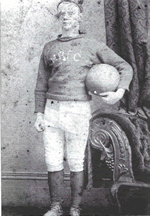 Manchester United (change strip worn at Sheffield United March 1910 added), Middlesbrough (3 variant kits added for 1972-73). I've tidied up Millwall's early kit history, removing a couple of strips I now believe to have been change kits and correcting the date the club changed their name from Rovers to Athletic. The photograph on the left is of Jasper John Sexton, the club's first secretary. His father ran a beer shop in Tooke Street where the team would change before matches.
Manchester United (change strip worn at Sheffield United March 1910 added), Middlesbrough (3 variant kits added for 1972-73). I've tidied up Millwall's early kit history, removing a couple of strips I now believe to have been change kits and correcting the date the club changed their name from Rovers to Athletic. The photograph on the left is of Jasper John Sexton, the club's first secretary. His father ran a beer shop in Tooke Street where the team would change before matches.
My thanks to Richard Essen for sending me detailed confirmation of the team's early kit history
(Photograph Millwall FC: Images of Sport 1999)
30 March
 On March 16 I published a photograph of Portsmouth wearing black socks with white turnovers against Arsenal. This prompted Senior HFK Elf Tony Sealey to search his family collection and establish that the team wore their regular red socks (shown left) until at least February 1957, which suggest the black stockings were adopted for the last part of the season. Tony has also provided more details on when and why Pompey adopted red socks in te first place and corrected the 1962-63 alternate kit.
On March 16 I published a photograph of Portsmouth wearing black socks with white turnovers against Arsenal. This prompted Senior HFK Elf Tony Sealey to search his family collection and establish that the team wore their regular red socks (shown left) until at least February 1957, which suggest the black stockings were adopted for the last part of the season. Tony has also provided more details on when and why Pompey adopted red socks in te first place and corrected the 1962-63 alternate kit.
(Photograph taddyclown.co.uk)
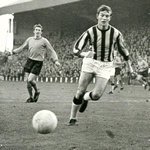 I came across this oddity while trawling through the Senior Tigers Club website. It's from a match between Hull City and Crystal Palace. The south London team are wearing conventional 2" stripes rather than the candy stripes they adopted at the beginning of the season. This might be a one-off but perhaps our Palace Elves can shed light on this mystery.
I came across this oddity while trawling through the Senior Tigers Club website. It's from a match between Hull City and Crystal Palace. The south London team are wearing conventional 2" stripes rather than the candy stripes they adopted at the beginning of the season. This might be a one-off but perhaps our Palace Elves can shed light on this mystery.
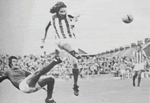 Last week I reported that I had removed the striped 1974-75 striped kit from the Gillingham section because I thought it was a change strip. Simon Hart has now uncovered evidence that the Gills did indeed wear stripes in at least five home matches between August and October 1974. The photographs shows them playing Aldershot in September. To confuse matters further, they also wore their new blue shirts with white flappy collars in a home match against Charlton Athletic on 31 August. These seem to have been reintroduced in October.
Last week I reported that I had removed the striped 1974-75 striped kit from the Gillingham section because I thought it was a change strip. Simon Hart has now uncovered evidence that the Gills did indeed wear stripes in at least five home matches between August and October 1974. The photographs shows them playing Aldershot in September. To confuse matters further, they also wore their new blue shirts with white flappy collars in a home match against Charlton Athletic on 31 August. These seem to have been reintroduced in October.
(Photograph Gillingham FC Scrapbook)
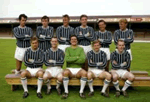 For some time I have suspected that Southend United adopted navy and white rather earlier in the Sixties than my records have shown. The evidence was sketchy, however: some black and white photographs of their candy striped shirts (1961-65) seem very dark while I have a memory of watching them play Southport in 1966 wearing rather scruffy, faded dark blue tops but memory can play tricks. Other black & white photographs I have seen from this period are equally ambiguous. This team group, kindly submitted by Peter Stevenson, appears to confirm that the Shrimpers did indeed wear navy and white during 1964-65 and almost certainly as far back as 1961.
For some time I have suspected that Southend United adopted navy and white rather earlier in the Sixties than my records have shown. The evidence was sketchy, however: some black and white photographs of their candy striped shirts (1961-65) seem very dark while I have a memory of watching them play Southport in 1966 wearing rather scruffy, faded dark blue tops but memory can play tricks. Other black & white photographs I have seen from this period are equally ambiguous. This team group, kindly submitted by Peter Stevenson, appears to confirm that the Shrimpers did indeed wear navy and white during 1964-65 and almost certainly as far back as 1961.
25 March
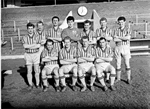 Photographic evidence submitted by Peter Stevenson confirms that Port Vale changed from black to amber shorts in January 1962. This team group was taken on 15 February, two days before Vale met Fulham in the FA Cup 5th Round two days later. Leyton Orient (February-May 1965 corrected), Halifax Town (1964-65).
Photographic evidence submitted by Peter Stevenson confirms that Port Vale changed from black to amber shorts in January 1962. This team group was taken on 15 February, two days before Vale met Fulham in the FA Cup 5th Round two days later. Leyton Orient (February-May 1965 corrected), Halifax Town (1964-65).
I've removed the striped 1974-75 strip from the Gillingham section as I now have evidence that this was a change strip.
24 March - More from the Senior Tigers Club
Northampton Town (sequence of changes to socks between 1964 and 1967 now accurately dated), Cardiff City (1966-67), Millwall (1966-67), Bolton Wanderers (1966-67), Sheffield United (1968-69), Huddersfield Town (1969-70 shirt without crest added), Leicester City (1969-70 late).
20 March - More from the Sixties
Exeter City (1965-66), Bristol Rovers (1965-66 stripes adjusted), Shrewsbury Town (1965-66 shorts detailing added), Brentford (1965-66 facings & socks corrected), Peterborough United (1964-65, 1965-66 amended).
19 March
 Thanks to the large collection of team photographs on the Senior Tigers Club website I've completed a substantial revision of the Hull City section between 1904 and 1964. In the process I think I have disproved a contemporary report in the Derby Daily Telegraph stating that the team had been granted permission to wear black and white in 1921-22. I have examined several team photographs from that season and found no evidence to support this but the team did switch from black to white knickers (see photo) so perhaps the writer had misunderstood his source.
Thanks to the large collection of team photographs on the Senior Tigers Club website I've completed a substantial revision of the Hull City section between 1904 and 1964. In the process I think I have disproved a contemporary report in the Derby Daily Telegraph stating that the team had been granted permission to wear black and white in 1921-22. I have examined several team photographs from that season and found no evidence to support this but the team did switch from black to white knickers (see photo) so perhaps the writer had misunderstood his source.
Bristol City (1963-64), Barnsley (1964-65), Lincoln City (1964-65 corrected), Bournemouth & Boscombe Athletic (1964-65), Gillingham (1964-65 corrected), Bristol Rovers (1964-65 detailing tweaked).
18 March
Plymouth Argyle (1958-59), Swindon Town (1958-60 V neck adjusted), Reading 1957-1958, 1958-1962 hoops redrawn), Stockport County (1956-59 socks revised), Doncaster Rovers (1958-59, 1959-60 socks corrected), Southend United (1957-59 V neck corrected), Colchester United (March 1959), Tranmere Rovers (1957-62 socks corrected), Rochdale (1958-59 V neck corrected), Cardiff City (1959-60 socks corrected), Huddersfield Town (1959-61 V neck corrected), Bristol Rovers (1959-62), Brighton & Hove Albion (1959-60 socks corrected).
17 March
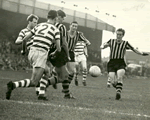 First feature today is of Hull City playing Carlisle United at Boothferry Park in August 1962. The visitors are wearing hooped shirts, a short-lived break with tradition that lasted just two seasons.
First feature today is of Hull City playing Carlisle United at Boothferry Park in August 1962. The visitors are wearing hooped shirts, a short-lived break with tradition that lasted just two seasons.
Southend United (1961-62, 1962-63 x2, 1963-64 added), Bristol Rovers (18 August 1962 - the team wore four different shirts that season), Crystal Palace (September 1962 - yet another variation of a classic), Workington (1962-63 added), Halifax Town (1962-63 added), Queen's Park Rangers (1962-63 corrected).
Today's photograph and much of the material posted today here comes from seniortigers.org.uk, a site dedicated to the history of Hull City AFC with some excellent galleries of team and action photographs, particularly from the early 1960s.
16 March - Bits & Bobs
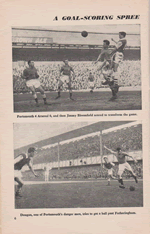 This photograph, submitted by Dick Waite, shows Portsmouth playing Arsenal at Fratton Park in March 1958. The point of interest is that Pompey are wearing black socks with white turnovers rather than the plain red ones adopted in 1947. I haven't been able to find any other action photographs to corroborate this but we do know that a month later the team wore hooped socks when they played at Luton Town, which would make sense if the change was made to avoid a clash with the home team's socks.
This photograph, submitted by Dick Waite, shows Portsmouth playing Arsenal at Fratton Park in March 1958. The point of interest is that Pompey are wearing black socks with white turnovers rather than the plain red ones adopted in 1947. I haven't been able to find any other action photographs to corroborate this but we do know that a month later the team wore hooped socks when they played at Luton Town, which would make sense if the change was made to avoid a clash with the home team's socks.
Newcastle United (1975-76 change socks corrected), Dunfermline Athletic (1971-72 crest corrected), East Fife (1963-70 re-ordered), St Mirren (1966-68 reordered as warm and cold weather kits, 1968-69 added),
11 March
 Chesterfield Town (1903-05 knickers & socks confirmed). The photograph shows the team playing Chelsea at Stamford Bridge in October 1905 after Chesterfield had reverted to plain white shirts. (Photograph Illustrated Sporting & Dramatic News 28 October 1905).
Chesterfield Town (1903-05 knickers & socks confirmed). The photograph shows the team playing Chelsea at Stamford Bridge in October 1905 after Chesterfield had reverted to plain white shirts. (Photograph Illustrated Sporting & Dramatic News 28 October 1905).
One of our senior HFK Elves, Richard Essen, has immersed himself in the archives 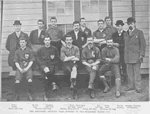 of the Middlesex Independent to investigate Brentford's earliest colours and we now have an almost complete narrative from 1889 to 1903. Most notable is Richard's discovery that the team wore plain red shirts between 1892 and March 1895. These can be seen in the team photograph on the right of the team that won the Middlesex Junior Cup in April 1894.
of the Middlesex Independent to investigate Brentford's earliest colours and we now have an almost complete narrative from 1889 to 1903. Most notable is Richard's discovery that the team wore plain red shirts between 1892 and March 1895. These can be seen in the team photograph on the right of the team that won the Middlesex Junior Cup in April 1894.
Richard has also managed to plug the large gap in our Lincoln City records (1912-21) and discover two unrecorded Bradford (Park Avenue) strips (1916-17, 1917-18).
10 March
Aldershot Town (1992-93, 1993-95 revised, early crests updated).
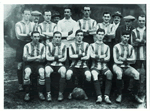 This is the first ever Leicester City team taken at the start of the 1919-20 season. As Leicester Fosse they had adopted striped shirts in 1915 but these were worn with white knickers. (1905-06 collar corrected, 1919-20, 1920-21 & 1922-23 added.)
This is the first ever Leicester City team taken at the start of the 1919-20 season. As Leicester Fosse they had adopted striped shirts in 1915 but these were worn with white knickers. (1905-06 collar corrected, 1919-20, 1920-21 & 1922-23 added.)
(Photograph Leicester Mercury)
9 March
Newcastle United wore all-yellow with blue trim at Swansea City in December 1980. This was probably because the match was televised and the BBC would not allow them to wear their regular change strip (which was trimmed in green) with sponsorship. Crystal Palace strips 1973-75 now sorted into cold and warm weather versions. After negotiations with KLM broke down late in the 1994-95 season Brentford wore shirts without sponsorship. The situation continued into the following season before a deal was struck with Ericsson.
2017-18 Scottish Club Detailing Update: Rangers (2nd, 3rd), Hamilton Academical, Dunfermline Athletic.
3 March
2019-20 Update: Queens Park Rangers (new sponsor added), Middlesbrough (3rd added), Wolverhampton Wanderers (Europa League 3rd added), Dundee (3rd added).
2 March - 2016-17 Scottish Club Update
Detailing added to Rangers (2nd, 3rd), Motherwell (1st), St Johnstone (1st), Ross County (1st), Partick Thistle (1st), Dundee (1st). My thanks to Ian McConnel for this material.
International Update
Scotland: 1908 added, 1980 v Portugal added.
FIFA World Cup 1990: Colombia shorts trim corrected.
28 February - More Early Villa Material
We now know that Charles Alcock's Football Annual & the FA Handbook record Aston Villa's colours for 1877-78 as red and blue. I have moved the black and white hooped kit to the Change Kits Section. There are two primary references concerning the black and white tops worn from May 1886. In his book, The Triumphs of the Football Field, Archie Hunter mentions a "piebald uniform" and The Athletic News describes the tops as "black & white stripes." I now believe these would have been horizontal stripes.
In the course of our correspondence about Villa's colours, Bernard Gallagher sent me a quote from the Villa News & Record from January 1920 in which a journalist recalls watching Bolton Wanderers wearing "white jerseys with blobs of scarlet about the size of threepenny-bits all over them." This the first corroboration I have received of the unique tops worn by the Lancashire team around 1884. Regular visitors may recall that my original graphic for the piebald tops included red and white irregular blotches. It is now clear to me that this was due to contributors misinterpreting the 1920 account given here.
 I make no apology for presenting this photograph of a scratch team from the 1880s once again. Using clues from The Straw Plaiters website and access to old newspaper archives, Simon Monks believes he has identified them. According to a report in the Sevenoaks Chronicle & Kent Advertiser a match was played at Goudhurst on 9 April 1885 between a team
I make no apology for presenting this photograph of a scratch team from the 1880s once again. Using clues from The Straw Plaiters website and access to old newspaper archives, Simon Monks believes he has identified them. According to a report in the Sevenoaks Chronicle & Kent Advertiser a match was played at Goudhurst on 9 April 1885 between a team 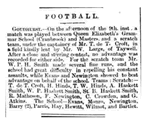 drawn from pupils and masters from Queen Elizabeth's Grammer School (Cranbrook) and a scratch team captained by Mr T de T Croft. It is known that the players standing second from the left is Algernon Haskett-Smith and, according to the report, two of his brothers also appeared in the side. Simon believes the player wearing a Kent FA cap next but one to Algernon is Walter Parry Haskett-Smith, an eminent rock climber who wrote an important book on the subject. Algernon, who appears to be wearing an Oxford University shirt, died in a shooting accident two years after this photograph was taken.
drawn from pupils and masters from Queen Elizabeth's Grammer School (Cranbrook) and a scratch team captained by Mr T de T Croft. It is known that the players standing second from the left is Algernon Haskett-Smith and, according to the report, two of his brothers also appeared in the side. Simon believes the player wearing a Kent FA cap next but one to Algernon is Walter Parry Haskett-Smith, an eminent rock climber who wrote an important book on the subject. Algernon, who appears to be wearing an Oxford University shirt, died in a shooting accident two years after this photograph was taken.
Stockport County (1906-07, 1907-08 added).
27 February
 Some more pieces of the complicated jigsaw of Aston Villa's early kit history have fallen into place. Thanks to Bernard Gallagher we finally have details of the unique halved shirts in two shades of green worn at the end of the 1883-84 season. Bernard has asked me not to reproduce the photograph while he tries to track down the owner but you can view it on his new The Claret & Blue Blog. Bernard has also suggested that the "coral and maroon" tops recorded in 1885-86 featured coral blue rather than pink and were forerunners of the familiar claret and blue. The black jerseys recorded for 1883-84 are now confirmed to be a change kit while the photograph above confirms that the "quartered" jerseys recorded for 1889-90 were in fact what we now define as halved.
Some more pieces of the complicated jigsaw of Aston Villa's early kit history have fallen into place. Thanks to Bernard Gallagher we finally have details of the unique halved shirts in two shades of green worn at the end of the 1883-84 season. Bernard has asked me not to reproduce the photograph while he tries to track down the owner but you can view it on his new The Claret & Blue Blog. Bernard has also suggested that the "coral and maroon" tops recorded in 1885-86 featured coral blue rather than pink and were forerunners of the familiar claret and blue. The black jerseys recorded for 1883-84 are now confirmed to be a change kit while the photograph above confirms that the "quartered" jerseys recorded for 1889-90 were in fact what we now define as halved.
(Photograph Gottfried Fuchs Blogspot.)
18 February
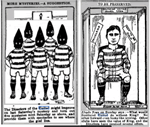 Our very good chum, Alick Milne, has been delving through the newspaper archives and has come up with a surprising find for 1910-11 when Southend United adopted red and gold hoops. Although no photographs are available of this outfit it did appear in a couple of cartoons published in the local press. Alick has also established that their original shirts were trimmed in black rather than navy. In the process I've also reassessed the photographic evidence that suggests the earlest shirts were light blue. Programmes and press reports, however, all
Our very good chum, Alick Milne, has been delving through the newspaper archives and has come up with a surprising find for 1910-11 when Southend United adopted red and gold hoops. Although no photographs are available of this outfit it did appear in a couple of cartoons published in the local press. Alick has also established that their original shirts were trimmed in black rather than navy. In the process I've also reassessed the photographic evidence that suggests the earlest shirts were light blue. Programmes and press reports, however, all 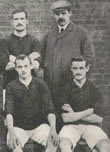 describe them as "blue" or even "royal blue" so I think the quality of these images is misleading.
describe them as "blue" or even "royal blue" so I think the quality of these images is misleading.
Alick's research confirms that the colours worn by the Burton United team in 1905-06 (right) were in fact green with red collars and cuffs. Alick also fills in quite a few gaps in the record of United's predecessor club, Burton Swifts (1886-87, added, 1892-97 knickers corrected).
South Shore (1898-99 added).
17 February
 This faded newspaper cutting from the Sheffield Daily Telegraph (16 January 1928) is the first photographic evidence I have seen that shows Rotherham United in their original amber and black jerseys. It confirms that these were worn with white knickers rather than the black I had previously assumed. There is also evidence that United retained Rotherham Town's old blue and white striped shirts as a change strip. My thanks to Richard Essen who has also found corroboration for Norwich City's white shirts with yellow and green chevrons which places this one season earlier than previously recorded. Sadly no photograph of this unique shirt has so far come to light.
This faded newspaper cutting from the Sheffield Daily Telegraph (16 January 1928) is the first photographic evidence I have seen that shows Rotherham United in their original amber and black jerseys. It confirms that these were worn with white knickers rather than the black I had previously assumed. There is also evidence that United retained Rotherham Town's old blue and white striped shirts as a change strip. My thanks to Richard Essen who has also found corroboration for Norwich City's white shirts with yellow and green chevrons which places this one season earlier than previously recorded. Sadly no photograph of this unique shirt has so far come to light.
 This photograph from theyflysohigh.co.uk shows West Ham United wearing unfamiliar tops in 1924-25. According to the Chelmsford Chronicle (29 August 1924) the Hammers reversed their normal jerseys for this season.
This photograph from theyflysohigh.co.uk shows West Ham United wearing unfamiliar tops in 1924-25. According to the Chelmsford Chronicle (29 August 1924) the Hammers reversed their normal jerseys for this season.
Southport (1924-25, 1925-26 socks corrected).
6 February
 Admiral may have revolutionised football kit design in the 1970's and created the market for replica kits but they did have some issues with quality control. This photograph of the 1978-79 Crystal Palace team shows three variants on the basic design and the version with the club badge did not appear until late September.
Admiral may have revolutionised football kit design in the 1970's and created the market for replica kits but they did have some issues with quality control. This photograph of the 1978-79 Crystal Palace team shows three variants on the basic design and the version with the club badge did not appear until late September.
St Johnstone (1956-57 added), Blackburn Rovers (2003-04 European kit added), Everton (1958-61 change socks corrected), Wolverhampton Wanderers (1979 crest replaced), Birmingham City (1992 crest replaced),
5 February - More Miscellany
Oldham Athletic (1987-89 graphics put into correct order and additional versions added), Kidderminster Harriers (1984-85 socks corrected), Lincoln City (1987-89 corrected), Rushden & Diamonds (2000-02 collar altered), Scarborough (1999-2000 shorts & socks corrected), West Bromwich Albion (1984-86 "No Smoking" sponsor logo replaced), Tranmere Rovers (2005-07 trim colour corrected).
4 February - Historical Miscellany
 Halifax Town (1926-29 socks confirmed - see left,
Halifax Town (1926-29 socks confirmed - see left, 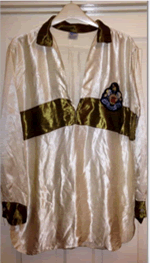 1934-34 & 1943-44 added), Luton Town (1970 crest corrected), Liverpool (1923-24 change strip added), Salford Amateurs (1963-64 added).
1934-34 & 1943-44 added), Luton Town (1970 crest corrected), Liverpool (1923-24 change strip added), Salford Amateurs (1963-64 added).
This unusual Newcastle United shirt first appeared in my inbox some considerable time ago but we have not been able to place it. In December, however, Phil Marriott spotted it on the club's Advent Calendar Twitter feed along with a long overdue explanation of its origin. It dates from November 1957 and was worn in a series of mid-week friendlies under improvised floodlights.
31 January - 2019-20 Update
Premier League: Chelsea (FA Cup special kit added), Southampton (4th added).
League One: Doncaster Rovers (charity kit added), Lincoln City (3rd shorts/socks confirmed), Portsmouth (2nd shirt trim added).
League Two: Crawley Town (1st socks corrected, 3rd added), Exeter City (2nd shirt detail added), Newport County (1st, 2nd shorts updated) Port Vale (1st, 2nd trim colour adjusted), Stevenage (charity kit added), Swindon Town (1st shorts trim added), Walsall (3rd shirt trim added), Bradford City (3rd shorts/socks trim added).
28 January
Richard Wall from the Suffolk FA has provided confirmation that Ipswich Town switched from dark blue shirts to stripes in 1888 although the team captain refused to wear the new shirts.
Richard Essen has been scouring the newspapers from the mid-twenties and come up with some little gems. Halifax Town (1926-27), Southend United (1922-23), Ashington (1923-24 socks updated), Aberdare Athletic (1924-27), Exeter City (switch from white to navy knickers confirmed 1924-25).
 Following on from Richard's email of 2 December I've added the navy and white strip worn in Queen's Park Rangers' opening fixtures of 1926-27, presumably because the new blue and white shirts were not ready in time (see photograph left).
Following on from Richard's email of 2 December I've added the navy and white strip worn in Queen's Park Rangers' opening fixtures of 1926-27, presumably because the new blue and white shirts were not ready in time (see photograph left).
The cuttings also confirm that Sunderland switched from navy to black knickers in 1926-27. There are also two references to West Ham United playing in red, white and blue jerseys instead of red and blue but I want to have this corroborated.
27 January
After an extended mid-winter break I'm back in the saddle and to kick-off I'd like to tie up a few loose ends from the Victorian period. Polytechnic (1893 missing graphic restored), Peterhouse College Cambridge (1886), Swifts (1877 cap  added & crest corrected), Reigate Priory (1892 updated from photograph), Rushden (1893), St Albans (1895), 2nd Scots Guards (1891), Wellingborough Town (1883), Wolverton LNWR (1890), Strathmore (1891), Derby Junction (1890).
added & crest corrected), Reigate Priory (1892 updated from photograph), Rushden (1893), St Albans (1895), 2nd Scots Guards (1891), Wellingborough Town (1883), Wolverton LNWR (1890), Strathmore (1891), Derby Junction (1890).
This wonderful photograph of an unknown Victorian team has featured before on HFK and it appears to show a scratch side of chums wearing their club or university shirts gathered together in a park somewhere. The player standing third from the left is wearing a Swifts shirt of 1877 vintage.
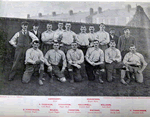 I've incorporated two South Shore strips (1879-80, 1893-94) into the Blackpool record. The two clubs merged in December 1899 when The Seasiders were briefly out of the Football League. The combined club was re-elected the following season (1900) and continue to play at South Shore's Bloomfield Road ground to this day. On the right is the 1893-94 South Shore team.
I've incorporated two South Shore strips (1879-80, 1893-94) into the Blackpool record. The two clubs merged in December 1899 when The Seasiders were briefly out of the Football League. The combined club was re-elected the following season (1900) and continue to play at South Shore's Bloomfield Road ground to this day. On the right is the 1893-94 South Shore team.
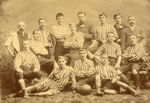 On the left is a very rare photograph of Strathmore FC from 1891-92. They merged with Johnstone Wanderers in 1894 and as Dundonians FC they successfully applied for a place in the Scottish Football League. Following objections from Dundee FC they changed their name to Dundee Wanderers before the start of the season. They found the standard too tough and after finishing next to last, they were not re-elected in 1895.
On the left is a very rare photograph of Strathmore FC from 1891-92. They merged with Johnstone Wanderers in 1894 and as Dundonians FC they successfully applied for a place in the Scottish Football League. Following objections from Dundee FC they changed their name to Dundee Wanderers before the start of the season. They found the standard too tough and after finishing next to last, they were not re-elected in 1895.
(South Shore and Strathmore photographs courtesy of The Straw Plaiters.)